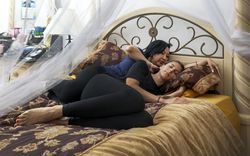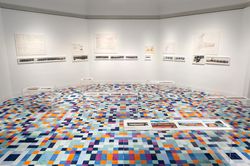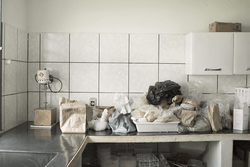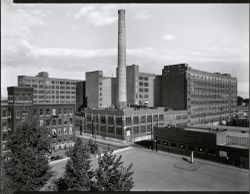drawings
Plans d'électricité
ARCH274842
Description:
Schéma pour la connexion des transformateurs et plan pour la connexion électrique du lave-vaisselle.
1931
Plans d'électricité
Actions:
ARCH274842
Description:
Schéma pour la connexion des transformateurs et plan pour la connexion électrique du lave-vaisselle.
drawings
1931
articles
A Social Reset
Giovanna Borasi, Catching Up With Life, Societal transformations, Solitude, Cuddling, Love, Age
1 March 2021
Cuddling Rooms, Body Banks, and Collab House
Giovanna Borasi on new needs for architecture
Actions:
A Social Reset
Ábalos Herreros constructed landscapes—or, more precisely, assembled them—by crudely juxtaposing a cast of semi-familiar characters. Novel to Spanish architecture in the 1980s, this pragmatic method of appropriation was developed and consistently employed as part of their design process. Borrowing, incorporating and transforming allowed ÁbalosHerreros to absorb the(...)
Octagonal gallery
23 July 2015 to 13 September 2015
Landscapes of the Hyperreal: Ábalos&Herreros selected by SO – IL
Actions:
Description:
Ábalos Herreros constructed landscapes—or, more precisely, assembled them—by crudely juxtaposing a cast of semi-familiar characters. Novel to Spanish architecture in the 1980s, this pragmatic method of appropriation was developed and consistently employed as part of their design process. Borrowing, incorporating and transforming allowed ÁbalosHerreros to absorb the(...)
Octagonal gallery
As the Earth’s climate reaches a state of constant instability, there is growing awareness of how global warming can affect human rights and increase social strife. Less attention has been paid to the ways in which political violence and human rights abuses, from past and present, constitute driving factors in the transformations of the global environment and climate.(...)
Paul Demarais Theatre
1 December 2016, 6pm
In the Frontiers of Climate Change (Toward a Politics of Nonhuman Rights)
Actions:
Description:
As the Earth’s climate reaches a state of constant instability, there is growing awareness of how global warming can affect human rights and increase social strife. Less attention has been paid to the ways in which political violence and human rights abuses, from past and present, constitute driving factors in the transformations of the global environment and climate.(...)
Paul Demarais Theatre
Series
AP193.S1
Description:
Series 1, Water Flux and Scrambled Flat, 2002-2010, documents the conception and evolution of a project that was originally a farm building and later became a geology and glaciology museum and research center focused on the Swiss Alps. The project was never realized. R&Sie(n) conceptualized Scrambled Flat as an experimental farm. The project goal was to reconcile European Union’s agricultural regulations, imposing a separation between animal and human living, to the community of Évolène traditional way of living, contiguously with animals, benefiting from the resources they offer. As conceived, Scrambled Flat creates an environment where fluidity between the existence of the animals and the humans is materialized. The size of the form is also adapted from a typical local rural house and exploits the heat of the animals and the insulation of the hay. For this project, R&Sie(n) approached the mayor of the community with the design proposition. The mayor then called for a competition, while also changing the program to an ecology museum and research center illustrating the local effects of global warming and the thawing of the Alps. R&Sie(n) won the competition with Water Flux, a reinterpretation of Scrambled Flat. The project was intended to uncover and exorcise the anxieties of ecological disaster, and the principle of flux related to seasonal change and, more broadly, climate change. The firm designed rooms that reproduce the geological and meteorological environment of the high mountains making it visible and experimental, offering refrigerated spaces for art installations and scientific demonstrations. The concept was also to build with the use of new technologies such as digital modelling, point scanning, and computer numerical control (CNC), combined with ancient local knowledge of knocking on trees to decide which specific pines have the best wood for construction. The building is designed to be constructed with local lamellar wood milled by nearby CNC. The resulting parts would be used for the structure, the insulation, the waterproofing and both the interior and exterior finishes. The design includes a grille wrapping the building, reproducing the profile of traditional houses and enclosure and making it possible to hold the snow inside a typo-morphological imprint. Therefore, the transformable envelope of the building reacts to the rhythm of the seasons. In the winter, the structure would appear like a solid cut-out of ice and snow, with cavities similar to those found in glaciers. In the summer, it would resemble piles of stones used in these areas to make borders. A small pool would collect rainwater and supply it to an interior artificial snowmaking system designed for the gallery. Transformation of the water is an integral part of the design. The records contain images of plans, sections, details for the structure of the façade, renderings, plans of the engineered structure, and photographs documenting the conception of the models with the CNC machinery. The Rhino 3D modelling files are also part of the records along with AutoCAD models and a video documenting the process. The records contain two physical models: a smaller polymer model at 1:20 scale representing the whole structure of the building, and a larger 1:1 latch wood fragment representing detail of the structure in its integrality.
2002-2010
Water Flux and Scrambled Flat
Actions:
AP193.S1
Description:
Series 1, Water Flux and Scrambled Flat, 2002-2010, documents the conception and evolution of a project that was originally a farm building and later became a geology and glaciology museum and research center focused on the Swiss Alps. The project was never realized. R&Sie(n) conceptualized Scrambled Flat as an experimental farm. The project goal was to reconcile European Union’s agricultural regulations, imposing a separation between animal and human living, to the community of Évolène traditional way of living, contiguously with animals, benefiting from the resources they offer. As conceived, Scrambled Flat creates an environment where fluidity between the existence of the animals and the humans is materialized. The size of the form is also adapted from a typical local rural house and exploits the heat of the animals and the insulation of the hay. For this project, R&Sie(n) approached the mayor of the community with the design proposition. The mayor then called for a competition, while also changing the program to an ecology museum and research center illustrating the local effects of global warming and the thawing of the Alps. R&Sie(n) won the competition with Water Flux, a reinterpretation of Scrambled Flat. The project was intended to uncover and exorcise the anxieties of ecological disaster, and the principle of flux related to seasonal change and, more broadly, climate change. The firm designed rooms that reproduce the geological and meteorological environment of the high mountains making it visible and experimental, offering refrigerated spaces for art installations and scientific demonstrations. The concept was also to build with the use of new technologies such as digital modelling, point scanning, and computer numerical control (CNC), combined with ancient local knowledge of knocking on trees to decide which specific pines have the best wood for construction. The building is designed to be constructed with local lamellar wood milled by nearby CNC. The resulting parts would be used for the structure, the insulation, the waterproofing and both the interior and exterior finishes. The design includes a grille wrapping the building, reproducing the profile of traditional houses and enclosure and making it possible to hold the snow inside a typo-morphological imprint. Therefore, the transformable envelope of the building reacts to the rhythm of the seasons. In the winter, the structure would appear like a solid cut-out of ice and snow, with cavities similar to those found in glaciers. In the summer, it would resemble piles of stones used in these areas to make borders. A small pool would collect rainwater and supply it to an interior artificial snowmaking system designed for the gallery. Transformation of the water is an integral part of the design. The records contain images of plans, sections, details for the structure of the façade, renderings, plans of the engineered structure, and photographs documenting the conception of the models with the CNC machinery. The Rhino 3D modelling files are also part of the records along with AutoCAD models and a video documenting the process. The records contain two physical models: a smaller polymer model at 1:20 scale representing the whole structure of the building, and a larger 1:1 latch wood fragment representing detail of the structure in its integrality.
Series
2002-2010
drawings
ARCH274506
Description:
Plans et détails de la distribution et de l'alimentation électrique selon les étages, des transformateurs et des disjoncteurs haute-tension.
1956
Plans et détails de la distribution et de l'alimentation électrique selon les étages
Actions:
ARCH274506
Description:
Plans et détails de la distribution et de l'alimentation électrique selon les étages, des transformateurs et des disjoncteurs haute-tension.
drawings
1956
models
AP056.S1.1990.PR04.008
Description:
This model has a lighting component that works with a transformer.
circa 1990
Project model, Canada Life Assurance Building Competition, Toronto
Actions:
AP056.S1.1990.PR04.008
Description:
This model has a lighting component that works with a transformer.
models
circa 1990
Photographers Clara Gutsche and David Miller offer their vision of the industrial landscape and architecture surrounding the urban historical site of Lachine Canal in Montréal. The Canal, which is over one hundred years old, suffered a long period of neglect after having played a key role in the development of Canadian industry. Fifteen years after the waterway closed,(...)
Octagonal gallery
15 July 1992 to 22 November 1992
An Industrial Landscape Observed: The Lachine Canal
Actions:
Description:
Photographers Clara Gutsche and David Miller offer their vision of the industrial landscape and architecture surrounding the urban historical site of Lachine Canal in Montréal. The Canal, which is over one hundred years old, suffered a long period of neglect after having played a key role in the development of Canadian industry. Fifteen years after the waterway closed,(...)
Octagonal gallery
drawings
ARCH274098
Description:
Études pour l'emplacement des poutres, colonnes et hourdis de la mezzanine, la chambre des transformateurs et des salles de cour. Cédule de coupe des murs.
circa 1940
Études pour l'emplacement des poutres, colonnes et hourdis de la mezzanine
Actions:
ARCH274098
Description:
Études pour l'emplacement des poutres, colonnes et hourdis de la mezzanine, la chambre des transformateurs et des salles de cour. Cédule de coupe des murs.
drawings
circa 1940
drawings
ARCH3134
Description:
Plan de la salle des transformateurs, de la salle des tableaux électriques (dessin 1123-8) / Canadian Comstock Company, Montréal.
1924
Plan de la salle de transformateur et des panneaux électriques
Actions:
ARCH3134
Description:
Plan de la salle des transformateurs, de la salle des tableaux électriques (dessin 1123-8) / Canadian Comstock Company, Montréal.
drawings
1924



